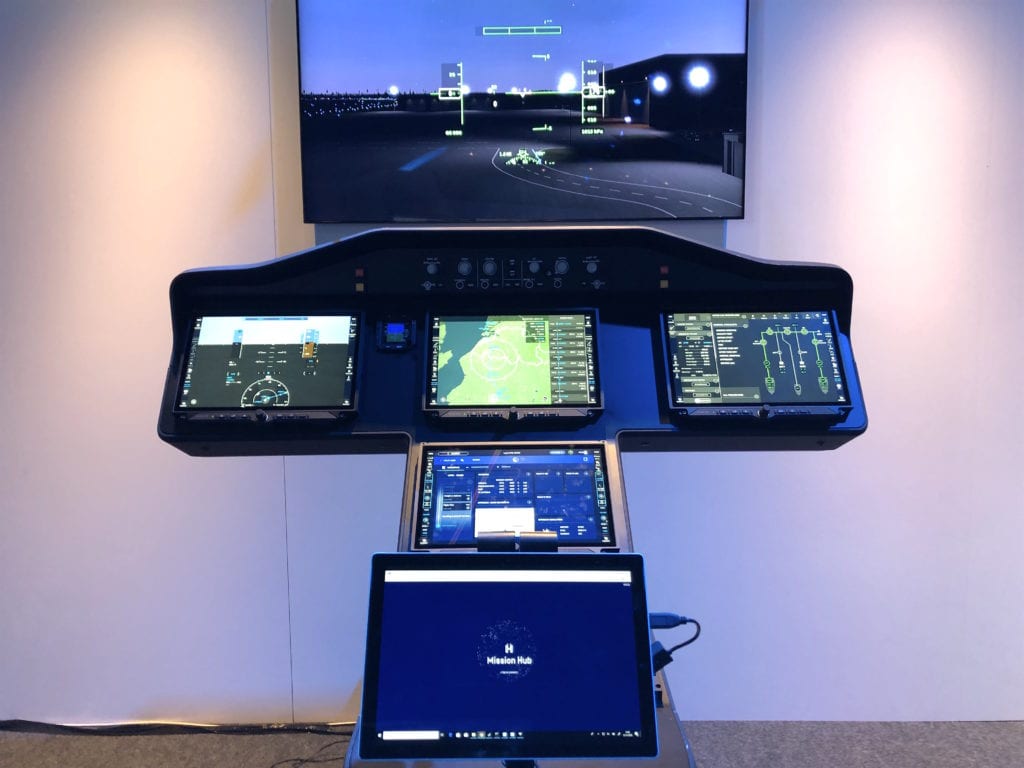
Thales’ research and development engineers showed a business jet concept of FlytX during their InnovDays 2019 event in Paris.
TOULOUSE, France – The research and development engineering division of Thales is working on a version of their touchscreen FlytX avionics suite with an artificial intelligence virtual pilot assistant for future business jet cockpits, according to an overview of the concept provided by the team during their InnovDays 2019 event in Paris.
A helicopter version of FlytX was first launched during the 2019 Paris Air Show, with Thales targeting certification and entry into service in 2022 for the French military’s fleet of Airbus H160Ms. Now a team of engineers is working on a variant of the touchscreen cockpit, which is designed to fly an aircraft completely using smart displays and no embedded avionics bay style computing, for the business jet market, according to Sebastien Boussiron, a senior research and development engineer for Thales.
“FlytX [is] an avionics solution that is already under development for helicopters. We’re now preparing this for the business jet market,” Boussiron told Avionics International. “In business jets, we’re already onboard several platforms in terms of electrical flight controls, but this would be our first full fledged avionics cockpit solution, to be in competition with Honeywell and Collins.”
Thales’ integrated modular avionics strategy incorporates the autopilot, flight management system, synthetic vision and other optional elements, all customized into FlytX, cutting down on the need for both federated hardware and dedicated controls to optimize size, weight and power (SWAP). The system integration and virtualization results in a 30-to-40 percent reduction in SWAP, according to the company, as well as a decreased need for line-replaceable units.

Another configuration of the touchscreen FlytX cockpit concept. Photo: Thales Aerospace
Boussiron explained how FlytX is designed to contain all of the computing power normally stored in avionics bays within smart displays instead, while still providing business jet pilots with a control column to fly the aircraft and a physical keyboard as backup. Another major focus within the development of FlytX is keep its architecture customizable, crew-centric and natively collected to a digital cloud where data for specific aircraft types and routes are available on a per-flight basis for pilots.
During a simulated demonstration flight between Le Bourget and Amsterdam, Boussiron also showed how Thales wants to integrate an artificial “virtual assistant” into the human machine interface that will provide both voice and flight intention recognition to pilots.
“Using artificial intelligence we want to introduce a virtual assistant that will help pilots with routine tasks,” Boussiron said. “For example, if air traffic controllers provide direction and tell the pilot ‘turn left heading 2-7-0,’ the assistant will interpret this voice command and propose its corresponding necessary flight control changes on the display. The pilot can then easily accept or reject that command. That’s one thing we want to stress is that the human pilot would always be in control.”
As the demonstration flight proceeded to enter the Amsterdam flight information region (FIR), the virtual assistant also proposed the new necessary frequency by which pilots would be able to communicate through voice with air traffic controllers in Amsterdam on a downward facing display. By dragging that frequency into the active frequency channel, that then becomes the new active frequency the pilot is using.
While in flight, pilots can also manipulate waypoints by changing the view of a display to show the entire flight plan. By swiping their finger along the visualized route, the autopilot is automatically updated to steer the aircraft to the next waypoint.
As part of bringing the FlytX concept to business aviation, Boussiron’s team is also creating a software development kit where business jet OEMs can build their own applications and host it within a cloud provided and managed by Thales called “Mission Hub.”
“We believe this will be ready to enter into service by 2025, there are still some regulatory hurdles to clear and more development to go through,” Boussiron said. “We are already in discussion with EASA about the concept.”